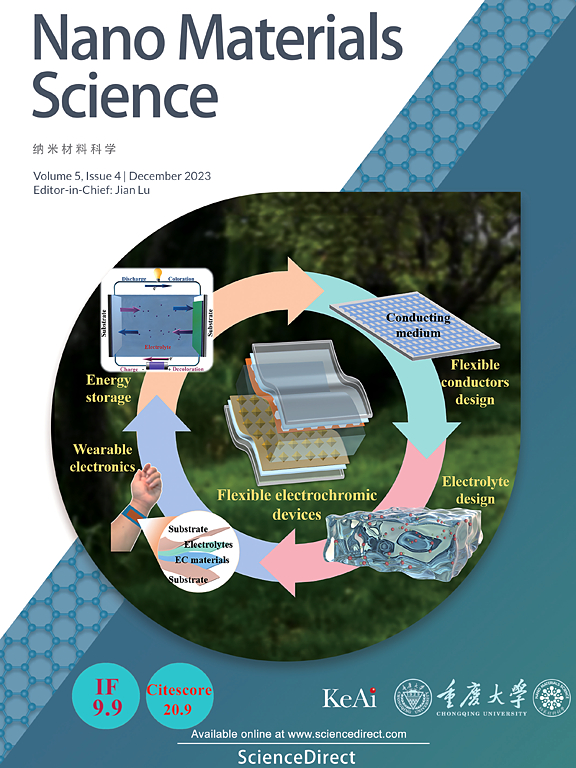通过同质异相界面工程操纵 NbS2-NiS2 纳米流中的偏振衰减,实现频带偏移的微波吸收
IF 17.9
2区 材料科学
Q1 Engineering
引用次数: 0
摘要
低能垒调节的均质异质(异相)界面对外加电场有快速响应,并能提供独特的界面极化,从而促进电子在衬底上的传输。这种界面上的调节对电磁波吸收材料的调制是有效的。本文将NiS2纳米颗粒均匀生长在NbS2空心纳米球中,构建了NbS2 - NiS2异质结构,这种特殊的结构增强了界面极化。界面处的强电子转移促进了电子在整个材料中的传递,从而减少了散射,促进了导电离子损失和介电极化弛豫,改善了介电损耗,使材料具有良好的阻抗匹配。因此,吸收带可以被成功调谐。通过调节NiS2的量,非均匀界面被精细地交替,从而使整体吸波性能转移到较低的频率。NiS2含量为15 wt%,吸收体厚度为1.84 mm时,在14.56 GHz处的最小反射损耗为- 53.1 dB,有效吸收带宽为5.04 GHz;更重要的是,不同波段的最小反射损耗为−20 dB,当厚度约为1.5 ~ 4.5 mm时,微波能量吸收率达到99%。本工作证明了均质异质结构的构建对提高电磁吸收性能是有效的,为高效电磁吸收材料的合成提供了指导。本文章由计算机程序翻译,如有差异,请以英文原文为准。
Manipulating polarization attenuation in NbS2–NiS2 nanoflowers through homogeneous heterophase interface engineering toward microwave absorption with shifted frequency bands
Homogeneous heterogeneous (heterophase) interfaces regulated with low energy barriers have a fast response to applied electric fields and could provide a unique interfacial polarization, which facilitate the transport of electrons across the substrate. Such regulation on the interfaces is effective in modulating electromagnetic wave absorbing materials. Herein, we construct NbS2–NiS2 heterostructures with NiS2 nanoparticles uniformly grown in NbS2 hollow nanospheres, and such particular structure enhances the interfacial polarization. The strong electron transfer at the interface promotes electron transport throughout the material, which results in less scattering, promotes conduct ion loss and dielectric polarization relaxation, improves dielectric loss, and results in a good impedance matching of the material. Consequently, the absorbing band may be successful tuned. By regulating the amount of NiS2, the heterogeneous interface is finely alternated so that the overall wave-absorbing performance is shifted to lower frequencies. With a NiS2 content of 15 wt% and an absorber thickness of 1.84 mm, the minimum reflection loss at 14.56 GHz is −53.1 dB, and the effective absorption bandwidth is 5.04 GHz; more importantly, the minimum reflection loss in different bands is −20 dB, and the microwave energy absorption rate reaches 99% when the thickness is about 1.5–4.5 mm. This work demonstrates the construction of homogeneous heterostructures is effective in improving the electromagnetic absorption properties, providing guideline for the synthesis of highly efficient electromagnetic absorbing materials.
求助全文
通过发布文献求助,成功后即可免费获取论文全文。
去求助
来源期刊

Nano Materials Science
Engineering-Mechanics of Materials
CiteScore
20.90
自引率
3.00%
发文量
294
审稿时长
9 weeks
期刊介绍:
Nano Materials Science (NMS) is an international and interdisciplinary, open access, scholarly journal. NMS publishes peer-reviewed original articles and reviews on nanoscale material science and nanometer devices, with topics encompassing preparation and processing; high-throughput characterization; material performance evaluation and application of material characteristics such as the microstructure and properties of one-dimensional, two-dimensional, and three-dimensional nanostructured and nanofunctional materials; design, preparation, and processing techniques; and performance evaluation technology and nanometer device applications.
 求助内容:
求助内容: 应助结果提醒方式:
应助结果提醒方式:


